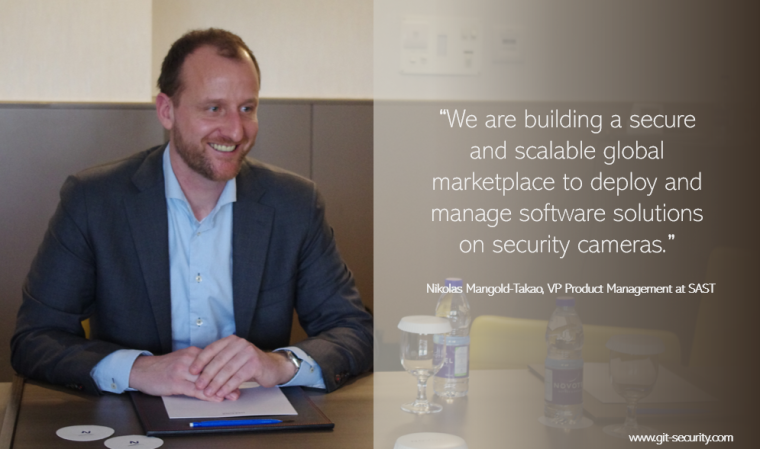One Operating System and Marketplace for Security Camera Apps
In September 2018, the security industry saw the launch of Security and Safety Things (SAST) in direct response to current trends for security cameras. SAST is a fully owned but in...

In September 2018, the security industry saw the launch of Security and Safety Things (SAST) in direct response to current trends for security cameras. SAST is a fully owned but independent Bosch start-up with 100 employees headquartered in Munich, Germany and is cooperating closely with the Open Security and Safety Alliance which was also founded in 2018. SAST announced ambitious goals and the vision to build a revolutionary IoT platform in the security camera segment. At Intersec in Dubai, GIT SECURITY asked Nikolas Mangold-Takao how SAST is moving forward and how far they are with the development of the operating system and the global marketplace.
GIT SECURITY: Nikolas, can we start with the bigger picture before we go into details? What is the background of SAST’s activities?
Nikolas Mangold-Takao: You see more and more things in various areas of our lives and different industries being connected Internet, creating the Internet of Things (IoT). In addition, this is fueled by Artificial Intelligence applications which allows to create new insights and use-cases based on the data of these things. With this we at SAST thought how to turn this into action for the physical security industry, where you see two additional trends: increasing compute power at the edge and increasing internet connectivity. Specifically for video security cameras we see with this the ability to create a new level of edge-based video analytics.
Can you now give us some more background about what SAST is actually working on to fulfill these demands?
Nikolas Mangold-Takao: We at SAST are creating an open Android-based Operating System for Video Security cameras, which was released end of last year in a first version. We also made a first reference camera model for development purposes available, as well as an Application Marketplace for developers to create and monetize their application. With this we are engaging with application developers who know the industry already but also with IT companies from outside the industry to develop apps on SAST. Overall we are working very closely with the Open Security & Safety Alliance, which was founded on the idea to create new business opportunities for our industry by creating a framework of standards for a common IoT infrastructure and Operating System.
Can you explain this in more detail and let us know what this means?
Nikolas Mangold-Takao: We are building a secure and scalable global marketplace to deploy and manage software solutions on security cameras. The operating system for cameras will be the similar to what you know from modern smart phones. This will allow developers to build applications on an open software standard, and to market them via the SAST app store, similar to today’s app stores for smartphone applications. One concrete example is that we hosted a hackathon were we invited Android and Computer Vision developers, and were positively surprised to see real working applications for a staged museum environment running on our reference camera just after two days.
Who will benefit from SAST’s activities?
Nikolas Mangold-Takao: First of all the users of security systems, since we strongly believe this all will drive more innovation, allow users to have a broader choice of applications to solve their needs and get solutions realized they have earlier not found on the market. Then of course the members of the Open Security & Safety Alliance work together in order to create a framework of standards and specifications for common components and develop a drive for improved levels of performance for security and safety solutions. And last-but-not-least, we open the security industry and the potential of millions of cameras to application developers inside and from outside our industry. They can provide solutions and know-how based on their vertical expert knowledge and knowledge from other industries.
At what stage are you at the start of 2019?
Nikolas Mangold-Takao: We have presented a MVP (Minimum Viable Product) of the operating system and we have produced a reference camera equipped with the operating system. Camera manufacturers and application developers can use them to test functionalities. The camera and the operating system are available for tests, so I would say, we are in the phase of a closed beta testing. We are planning to show first applications at ISC West in April this year.
Can you give us some details about how you developed the reference camera and how you interact with your partners?
Nikolas Mangold-Takao: We work closely together with camera manufacturers and chipset developers. The challenge was to find a universal next generation model as a base and reference that still allows manufacturers to differentiate for example in image technology or Cyber Security. The reference camera is like a building kit. At the end of the day, we as SAST need to make sure that the applications run on the reference camera and commercial cameras built in the future.
Working directly with chipset manufacturers should deliver you a lot of information about the future of video technology. Can you give us some insights?
Nikolas Mangold-Takao: They are increasingly able to support AI and Machine Learning with the next generation of their high-performance processors. The chipsets you see in your smartphone today have multiple high performance CPUs and GPUs – I am really exciting to putting these kind of chipsets to work in our industry.
Where do you see the biggest potential for applications?
Nikolas Mangold-Takao: Facial recognition software at airports is an example where you compare a face recorded by surveillance cameras with photos from a database in real-time. Future platforms will go somewhat further than this: It cannot only detect objects in videos but also patterns of human behavior, and it can interpret these in accordance with the relevant context. Video analysis is also used in the retail sector, in restaurants or the transport sector in order to research customer behavior, waiting times or visitor numbers. In addition to pure data processing, software can carry out additional tasks for video analysis: For example, automatically sending notifications or even initiating measures. And all of this takes place in real-time. The user is therefore dealing with intelligent systems that not only provide unprocessed video footage, but also provide added value. And they don’t have to switch cameras for the app installation
What are other future developments you have seen that will influence the market?
Nikolas Mangold-Takao: In addition to high-performance hardware and specialized applications it will be interesting to see what role 5G mobile technology will play for our market. This new communications standard is due to be launched in 2020 and promises to transfer data 100 times quicker than the current LTE. This not only allows for fast updates or video streaming. Its importance is much more significant: 5G makes the forthcoming IoT revolution possible in the first place. The greater capacities and fast response times of 5G offer numerous new opportunities in the field of network cameras. This will allow devices and systems from our industry to connect with systems from other domains, e.g. intelligent traffic solutions directly over a mobile connection.
Finally, can you explain to us how your business model works?
Nikolas Mangold-Takao: We are offering the operating system and the development environment for application developers for free. Like other app stores, our business model is to get a revenue share for every app sale via our app store. For companies that develop applications like a video analytics software, this is a very attractive offering as it lowers the costs and hurdles for them to enter the security market. They don’t have to negotiate and develop adjustments with every single camera vendor in the market. Our value proposition is visibility on a global market place, based on an established development environment, ready to go with billing and payment services.
When will the marketplace be ready?
Nikolas Mangold-Takao: At the end of this year, the app store will be online, and we expect the first transactions early in 2020.













